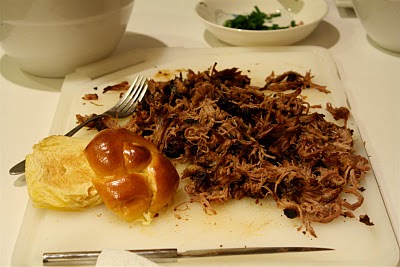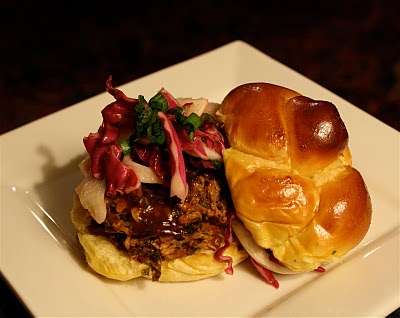Robbie said he has tried several cooking times and temperatures, but recommended that if I had an afternoon to kill, the best results are achieved by cooking the pork uncovered at a very low temperature (250 degrees) for 5 hours, and braising it in BBQ sauce towards the end to develop the "bark"--the crusty exterior. He doesn’t brine at all, which cuts down on the time.
Still, I was swayed by the feeling of destiny I had when I walked in the door and saw the
Cook’s Illustrated, and after my inquiries, I decided to more or less follow their method. The result was incredibly bark-y and delicious, but perhaps not as moist as the versions I had eaten at Robbie’s, and though I made two different sauces, I am sad to report that both paled in comparison to the one slathering all that tender pork in the sandwich from Vermont.
From my kitchen, still striving for indoor pork perfection, to yours,
Phoebe,
THE QUARTER-LIFE COOK**Recipes**
Pulled Pork Sandwiches with Fennel-Cabbage SlawMakes 4-6 servingsCook’s Illustrated featured three different options for the sauce, and being the indecisive person I am, I went with none of them, and instead made two different versions of my own. One is ketchup based, similar to what is used on this
Manchurian Cauliflower, and the other was inspired by my friend
Graeme’s BBQ sauce. The Fennel-Cabbage slaw was based on the one used by
Last Night’s Dinner on her
Food52 winning
Smokey Pork Burger, and it added the perfect refreshing crunch to the sandwiches.
As for the method, I am going to tell you exactly what I did including the brine. But I can't wait to try it Robbie’s way, skipping the brine, and cooking it for 5 hours uncovered at 250 degrees. Also, if you want to save on time and ingredients, you can skip the wet-dry rub combo. Last but not least, Cara recently made pork butt the Momofuku way, and we'll be posting about the results of that soon.
IngredientsFor the pork sandwich:
1 cup salt
½ cup sugar
4 cups water
1 3lb pork butt
¼ cup mustard (Bone Suckin, or honey mustard would be interesting here)
1 tsp salt
1 tbsp sugar
1 tbsp chili powder (I used ground ancho)
¼ tsp cayenne
4-6 toasted challah or brioche rolls - something dense, buttery, and more substantial than your average hamburger bun.
In a large bowl or container, combine the salt, sugar, and water, and stir to dissolve. Submerge the pork in the brining liquid (I used a can of beans inside a ziplock bag to weight it), cover tightly, and refrigerate for 2 hours.
Preheat the oven to 350 degrees. Cover a baking dish with foil (trust me, you don’t want to have to clean this).
Remove the pork from the brine and pat dry with paper towels. On a work surface, using your hands, cover the entire surface area of the pork butt with the mustard. In a small bowl, combine the remaining salt, sugar, chili powder, and cayenne. Sprinkle the dry rub over the pork until fully covered.
Transfer the pork to the baking dish. Cover the dish with tin foil, tenting it in the middle so it is not touching the pork. Place in the oven and cook for 3 hours. Remove the foil and cook for an additional 1 ½ hours, or until the internal temperature is 200 degrees.

Remove the pork from the oven and allow to rest, tented with foil, on a work surface for 20 minutes. Shred the pork with two forks. Combine the pork with your desired sauce (recipes below) until moist and lightly dressed - you don’t want to overwhelm the pork flavor, and you can serve extra on the side for dipping as desired.
To serve, top each bun with a mound of pork, a spoonful of slaw (see recipe below), and extra sauce on the side.
NOTE: Pulled pork can last up to a week in the fridge. Store the meat and the sauce separately. When you want to eat it again, combine the two and microwave together so the pork stays moist.
 Fennel-Cabbage SlawMakes 4 servingsIngredients
Fennel-Cabbage SlawMakes 4 servingsIngredients1 lemon, juiced
1 tbsp Dijon mustard
½ tbsp cider vinegar
1 tsp sugar
½ tsp salt
1 tbsp olive oil
2 large fennel bulbs, trimmed, tough outer leaves removes, and very thinly sliced
1 small head of red cabbage, heart removed, thinly sliced
4 scallions, white and green parts, thinly sliced
In a medium bowl, whisk together the lemon juice, mustard, vinegar, sugar, and salt. Add the remaining ingredients and toss to combine.
Cilantro BBQ SauceMakes about 2 cupsIngredients10 cloves garlic, minced
2 jalapeno peppers, seeds and ribs removed, minced
1 1/2 cups generic BBQ sauce
1 leaves from 1 bunch of cilantro, finely chopped
½ cup beef broth
In a medium non-stick skillet, sauté the garlic and jalapeno in ½ tablespoon of olive oil over low heat. When soft and fragrant but not browned, add the BBQ sauce. Bring to a simmer, stir in cilantro, and cook gently for 5-10 minutes, until the cilantro leaves begin to melt away and the sauce has thickened.
Remove from heat, and whisk in ¼ to ½ cup beef broth - you want the sauce rather thin so it moistens the pork without overwhelming it.
Mix with the pork, or store in an airtight container for up to two weeks.
Smoky Chipotle SauceMakes about 1 cup Ingredients7 cloves garlic
1 cup ketchup
2 canned chipotle peppers in adobo
3 tbsp adobo sauce from can
½ cup beef broth (or water)
In a medium non-stick skillet, sauté the garlic 1 tablespoon of olive oil over medium heat. When just beginning to brown, add the ketchup. Bring to a simmer, stir in chipotle and adobo, and cook gently for 5-10 minutes, until the sauce has reduced by almost half.
Remove from heat, and whisk in ¼ to ½ cup beef broth - you want the sauce rather thin so it moistens the pork without overwhelming it.
Mix with the pork, or store in an airtight container for up to two weeks.






